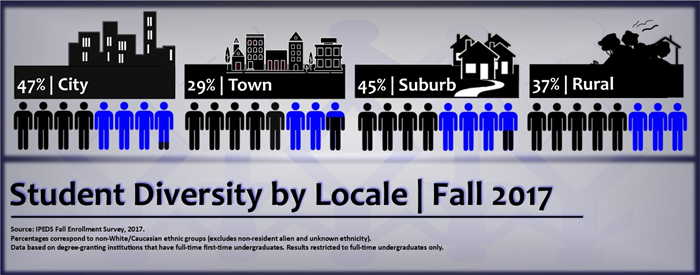Pepperdine OIE IR Report: Student Diversity by Locale

See full report (PDF)
Introduction
Pepperdine is committed to the highest standards of academic excellence and Christian values, where students are strengthened for lives of purpose, service, and leadership. Pepperdine’s mission stems from its Christian heritage, and it is this heritage that contributes to Pepperdine's commitment to student diversity. Incorporating diverse views in the classroom is critical to enriching the educational experience of college students and for preparing students for post-college employment (Turner, Gonzalez, & Wood, 2008). This OIE IR Report provides a snapshot of full-time undergraduate diversity at Pepperdine, in comparison to urban, suburban, and rural institutions in the United States.
Method
National data are based on IPEDS Fall Enrollment Survey for 2017, specifically for degree-granting institutions that have full-time, first-year undergraduates. Degree of urbanization is based on IPEDS methodology (see IPEDS Glossary, Degree of Urbanization), such that institutions are categorized as city, town, suburb, and rural. Analyses exclude non-resident alien students as well as students with an unknown race/ethnicity. In addition, analyses are restricted to full-time undergraduates only.
Results
Percentages correspond to non-White/Caucasian students. Nationally, institutions located in cities and suburbs were more diverse when compared to institutions located in towns and rural communities. Pepperdine’s undergraduate population was 40% diverse in Fall 2017, which was slightly more diverse than rural communities.
Conclusion
Structural diversity is reflected in the physical counts of non-White students enrolled at an institution (Hurtado, Griffin, Arellano, & Cuellar, 2008). Pepperdine’s undergraduate student enrollment for non-White students has steadily increased in the past decade (see OIE Diversity Part I Research Brief). Per IPEDS standards, Pepperdine is classified as a large suburb; however, Pepperdine’s remote location in a beach community approximately 35 miles northwest of the City of Los Angeles could be contributing to its undergraduate diversity numbers being more reflective of a rural area versus a suburb or town.



